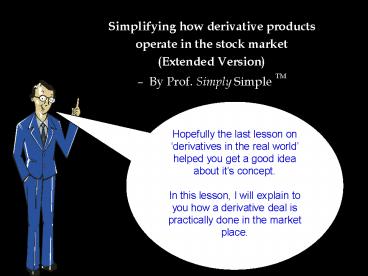Money Market - PowerPoint PPT Presentation
1 / 18
Title:
Money Market
Description:
Simplifying how derivative products operate in the stock market (Extended Version) By Prof. Simply Simple TM Hopefully the last lesson on derivatives in the ... – PowerPoint PPT presentation
Number of Views:74
Avg rating:3.0/5.0
Title: Money Market
1
Simplifying how derivative products operate in
the stock market(Extended Version) By Prof.
Simply Simple TM
Hopefully the last lesson on derivatives in the
real world helped you get a good idea about
its concept. In this lesson, I will explain to
you how a derivative deal is practically done in
the market place.
2
In our previous lesson we explained how in a
market comprising of several buyers and sellers,
one need not know who the counter-party is.
3
As we saw in our earlier lesson, there are
several farmers in the market, perhaps a few
thousands!
4
And several thousand bread manufacturers!!
5
And a market place where there is free flow of
information!!!
6
So that the expected future stock price (price of
wheat for the sake of comparison with our
previous examples) is known to every farmer and
bread manufacturer.
Any farmer trying to extract a higher price will
not be able to do so because for the bread
manufacturer there are several other farmers to
buy from and vice versa. This is what we call
Price Discovery.
7
Now in the stock market we do not have farmers
and bread manufacturers, but instead have
investors who are both buyers and sellers of
stocks.
8
Now lets say there is a stock A listed on the
stock exchange and its futures is quoted at Rs.
120. Also, lets assume there are participants
in the market to buy and sell the futures to each
other based on their contrarian view about the
stock. And lets say the expiry date for
settlement of the futures contract is after 5
days.
9
Now, for the sake of understanding, suppose you
were to buy a futures of stock A for Rs 120. In
this context, it is important for you to
understand that in a derivative product what you
actually do is take a view on future price
movements and at the end of the settlement
period, you reconcile based on whether your view
was right or wrong.
Since at no point in time the investor has to
take delivery of the stock, he does not have to
pay the entire price of the stock at the time of
the deal. All he has to pay hence is the margin
money which is a fraction of the price, say, 15
of the price which is Rs 18 in the above example.
10
Now to understand this better, lets look at
how the prices move in these 5 days.
11
Closing Price on day One 122 Your buying
price day One 120 Your profit Rs 2 So at
the end of the day your account with your broker
would get credited by Rs 2.
Day 1
Debit Credit
Day 1 Rs. 2
12
Closing Price on day two 125 Your profit as
compared to the previous day is Rs 3 So at the
end of day 2, your account with your broker would
get credited by Rs 3.
Day 2
Debit Credit
Day 1 Rs. 2
Day 2 Rs 3
13
Closing Price on day Three 124 Your loss as
compared to the previous day is Rs.1 So at the
end of day 3, your account with your broker would
get debited by Rs 1.
Day 3
Debit Credit
Day 1 Rs. 2
Day 2 Rs 3
Day 3 Rs.1
14
Closing Price on day Four 123 Your loss as
compared to the previous day is Rs.1 So at the
end of day 4, your account with your broker would
get debited by Rs 1.
Day 4
Debit Credit
Day 1 Rs. 2
Day 2 Rs 3
Day 3 Rs.1
Day 4 Rs. 1
15
Day 5 Settlement Date
Closing Price on day Five 125 Your profit as
compared to the previous day is Rs.2 So at the
end of day 5, your account with your broker would
get credited by Rs 2.
Debit Credit
Day 1 Rs. 2
Day 2 Rs 3
Day 3 Rs.1
Day 4 Rs. 1
Day 5 Rs 2
16
Day 5 Settlement Date
Thus the effect of the 5 days leading to the
settlement would be like this
Debit Credit
Day 1 Rs. 2
Day 2 Rs 3
Day 3 Rs.1
Day 4 Rs. 1
Day 5 Rs 2
Total Rs 2 Rs 7
So in this case the investor gained Rs 5 on
settlement date.
17
However since your investment was only Rs. 18
(15 margin money), you need to calculate Rs. 5
as a percentage of Rs. 18. Thus, the returns
earned would be equal to 5/18 x 100 27
(approx.)
18
- Please do let me know if I have managed to clear
this concept for you. Your feedback is very
important as it helps me plan my future lessons.
Hence please give your feedback at
professor_at_tataamc.com































